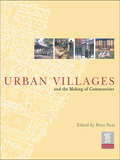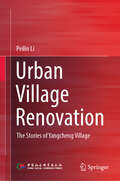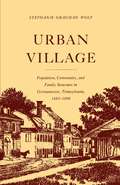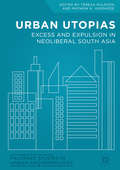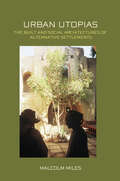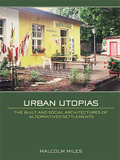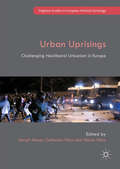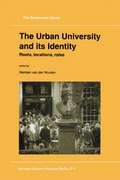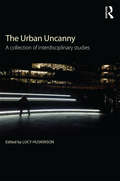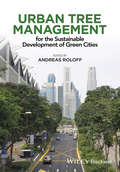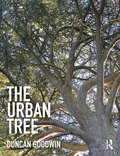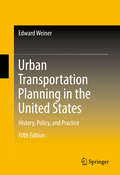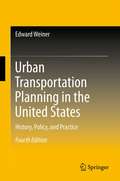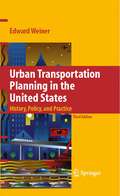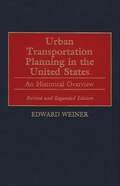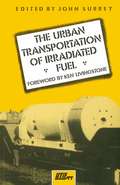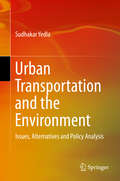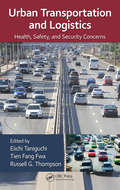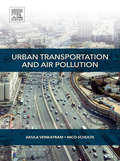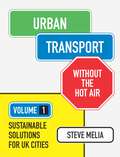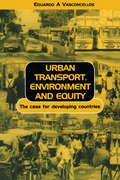- Table View
- List View
Urban Villages: The Making of Communities (PDF)
by NealUrban regeneration is currently at the forefront of the political and professional agenda worldwide. There is a growing desire to identify and deliver solutions that not only define models of sustainable and identifiable urban form, but also underpin a real sense of a vibrant community. The design philosophy of Urban Villages has gained significant weight with government policy-makers, planners, designers and developers and is becoming a popular model in achieving a successful and flexible urban renaissance. This book documents both the roots of the Urban Village movement and its application in contemporary society. A series of essays by eminent practitioners offers particular urban perspectives. A detailed compendium of successful case-studies provides clear technical information. Urban Villages and the Making of Communities offers a professional resource, a teaching tool and learning aid.
Urban Village Renovation: The Stories of Yangcheng Village
by Peilin LiThis book addresses the mystery and diversity of urbanization in China, especially with regard to urban villages. The “village in the city” is a unique social phenomenon in the process of Chinese urbanization. A local village society composed of deep-rooted social networks linked by blood, geography, folk beliefs, and folk customs is the outcome of a complex social process, which is accompanied by changes in property rights, restructuring of social networks, and conflicting benefits and values. The end of the village is the epitome of social transformation, and for China as a whole, this change may take a very long time to complete. This book includes various examples of and stories on urban villages, offering readers a wealth of insights into the phenomenon and its significance.
Urban Village: Population, Community, and Family Structure in Germantown, Pennsylvania, 1683-1800
by Stephanie Grauman WolfMost studies of eighteenth-century community life in America have focused on New England, and in many respects the New England town has become a model for our understanding of communities throughout the United States during this period. In this study of a mid-Atlantic town, Stephanie Grauman Wolf describes a very different way of organizing society, indicating that the New England model may prove atypical. In addition, her analysis suggests the origins of twentieth-century social patterns in eighteenth-century life. Germantown, Pennsylvania, was chosen for study because it was a small urban center characterized by an ethnically and religiously mixed population of high mobility. The author uses quantitative analysis and sample case study to examine all aspects of the community. She finds that heterogeneity and mobility had a marked effect on urban development--on landholding, occupation, life style, and related areas; community organization for the control of government and church affairs; and the structure and demographic development of the: family. Her work represents an important advance not only in our understanding of eighteenth-century American society, but also in the ways in which we investigate it.
Urban Utopias: Excess and Expulsion in Neoliberal South Asia
by Tereza Kuldova Mathew A. VargheseThis book brings anthropologists and critical theorists together in order to investigate utopian visions of the future in the neoliberal cities of India and Sri Lanka. Arguing for the priority of materiality in any analysis of contemporary ideology, the authors explore urban construction projects, special economic zones, fashion ramps, films, archaeological excavations, and various queer spaces. In the process, they reveal how diverse co-existing utopian visions are entangled with local politics and global capital, and show how these utopian visions are at once driven by visions of excess and by increasing expulsions. It’s a dystopia already in the making – one marred by land grabs and forced evictions, rising inequality, and the loss of urbanity and civility.
Urban Utopias: Excess and Expulsion in Neoliberal South Asia
by Tereza Kuldova Mathew A. VargheseThis book brings anthropologists and critical theorists together in order to investigate utopian visions of the future in the neoliberal cities of India and Sri Lanka. Arguing for the priority of materiality in any analysis of contemporary ideology, the authors explore urban construction projects, special economic zones, fashion ramps, films, archaeological excavations, and various queer spaces. In the process, they reveal how diverse co-existing utopian visions are entangled with local politics and global capital, and show how these utopian visions are at once driven by visions of excess and by increasing expulsions. It’s a dystopia already in the making – one marred by land grabs and forced evictions, rising inequality, and the loss of urbanity and civility.
Urban Utopias: The Built and Social Architectures of Alternative Settlements
by Malcolm MilesUtopia tends to generate a bad press - regarded as impracticable, perhaps nostalgic, or contradictory when visions of a perfect world cannot accommodate the change that is necessary to a free and self-organizing society. But people from diverse backgrounds are currently building a new society within the old, balancing literal and metaphorical utopianism, and demonstrating plural possibilities for alternative futures and types of settlement. Thousands of such places exist around the world, including intentional communities, eco-villages, permaculture plots, religious and secular retreats, co-housing projects, self-build schemes, projects for low-impact housing, and activist squats in urban and rural sites. This experience suggests, however, that when planning and design are not integral to alternative social formations, the modern dream to engineer a new society cannot be realized. The book is structured in four parts. In part one, literary and theoretical utopias from the early modern period to the nineteenth-century are reconsidered. Part two investigates twentieth-century urban utopianism and contemporary alternative settlements focusing on social and environmental issues, activism and eco-village living. Part three looks to wider horizons in recent practices in the non-affluent world, and Part four reviews a range of cases from the author’s visits to specific sites. This is followed by a short conclusion in which a discussion of key issues is resumed. This book brings together insights from literary, theoretical and practical utopias, drawing out the characteristics of groups and places that are part of a new society. It links today’s utopian experiments to historical and literary utopias, and to theoretical problems in utopian thought.
Urban Utopias: The Built and Social Architectures of Alternative Settlements
by Malcolm MilesUtopia tends to generate a bad press - regarded as impracticable, perhaps nostalgic, or contradictory when visions of a perfect world cannot accommodate the change that is necessary to a free and self-organizing society. But people from diverse backgrounds are currently building a new society within the old, balancing literal and metaphorical utopianism, and demonstrating plural possibilities for alternative futures and types of settlement. Thousands of such places exist around the world, including intentional communities, eco-villages, permaculture plots, religious and secular retreats, co-housing projects, self-build schemes, projects for low-impact housing, and activist squats in urban and rural sites. This experience suggests, however, that when planning and design are not integral to alternative social formations, the modern dream to engineer a new society cannot be realized. The book is structured in four parts. In part one, literary and theoretical utopias from the early modern period to the nineteenth-century are reconsidered. Part two investigates twentieth-century urban utopianism and contemporary alternative settlements focusing on social and environmental issues, activism and eco-village living. Part three looks to wider horizons in recent practices in the non-affluent world, and Part four reviews a range of cases from the author’s visits to specific sites. This is followed by a short conclusion in which a discussion of key issues is resumed. This book brings together insights from literary, theoretical and practical utopias, drawing out the characteristics of groups and places that are part of a new society. It links today’s utopian experiments to historical and literary utopias, and to theoretical problems in utopian thought.
Urban Uprisings: Challenging Neoliberal Urbanism in Europe (Palgrave Studies in European Political Sociology)
by Margit Mayer Catharina Thörn Håkan ThörnThis book analyses the waves of protests, from spontaneous uprisings to well-organized forms of collective action, which have shaken European cities over the last decade. It shows how analysing these protests in connection with the structural context of neoliberal urbanism and its crises is more productive than standard explanations. Processes of neoliberalisation have caused deeply segregated urban landscapes defined by deepening social inequality, rising unemployment, racism, securitization of urban spaces and welfare state withdrawal, particularly from poor peripheral areas, where tensions between marginalized youth and police often manifest in public spaces. Challenging a conventional distinction made in research on protest, the book integrates a structural analysis of processes of large scale urban transformation with analyses of the relationship between 'riots' and social movement action in nine countries: France, Greece, England, Germany, Spain, Poland, Denmark, Sweden and Turkey.
The Urban University and its Identity: Roots, Location, Roles (GeoJournal Library #45)
by HermanWustenThe chapters in this book are revised versions of papers initially presented at a confer ence on Universities and their cities held in Amsterdam on March 27-29 1996. There were about one hundred participants and 45 written contributions from Europe, the US, Canada and Australia. People with different disciplinary backgrounds, geographers, historians, sociologists, economists and planners among them, attended, as did a few university administrators and local government officials. The intricate relationships between universities and their cities were intensively debated from the perspective of possible contributions by the university to city life as well as from the angle of the city as a milieu that affects the university's functioning. There were theoretical and historical papers, and a series of case studies, some of them comparative, as well as proposals and descriptions of efforts to improve city-university relations. It was a fruitful occasion for many on account of the diversity of experience brought together for the purpose of a debate on a matter of common interest. The vari ous university settings within Amsterdam were visited during a guided tour that pro vided food for thought on the matters under discussion by means of a living example.
The Urban Uncanny: A collection of interdisciplinary studies
by Lucy HuskinsonThe Urban Uncanny explores through ten engaging essays the slippage or mismatch between our expectations of the city—as the organised and familiar environments in which citizens live, work, and go about their lives—and the often surprising and unsettling experiences it evokes. The city is uncanny when it reveals itself in new and unexpected light; when its streets, buildings, and people suddenly appear strange, out of place, and not quite right. Bringing together a variety of approaches, including psychoanalysis, historical and contemporary case study of cities, urban geography, film and literary critique, the essays explore some of the unsettling mismatches between city and citizen in order to make sense of each, and to gauge the wellbeing of city life more generally. Essays examine a number of cities, including Edmonton, London, Paris, Oxford, Las Vegas, Berlin and New York, and address a range of issues, including those of memory, death, anxiety, alienation, and identity. Delving into the complex repercussions of contemporary mass urban development, The Urban Uncanny opens up the pathological side of cities, both real and imaginary. This interdisciplinary collection provides unparalleled insights into the urban uncanny that will be of interest to academics and students of urban studies, urban geography, psychoanalysis, cultural studies, social studies and film studies, and to anyone interested in the darker side of city life.
The Urban Uncanny: A collection of interdisciplinary studies
by Lucy HuskinsonThe Urban Uncanny explores through ten engaging essays the slippage or mismatch between our expectations of the city—as the organised and familiar environments in which citizens live, work, and go about their lives—and the often surprising and unsettling experiences it evokes. The city is uncanny when it reveals itself in new and unexpected light; when its streets, buildings, and people suddenly appear strange, out of place, and not quite right. Bringing together a variety of approaches, including psychoanalysis, historical and contemporary case study of cities, urban geography, film and literary critique, the essays explore some of the unsettling mismatches between city and citizen in order to make sense of each, and to gauge the wellbeing of city life more generally. Essays examine a number of cities, including Edmonton, London, Paris, Oxford, Las Vegas, Berlin and New York, and address a range of issues, including those of memory, death, anxiety, alienation, and identity. Delving into the complex repercussions of contemporary mass urban development, The Urban Uncanny opens up the pathological side of cities, both real and imaginary. This interdisciplinary collection provides unparalleled insights into the urban uncanny that will be of interest to academics and students of urban studies, urban geography, psychoanalysis, cultural studies, social studies and film studies, and to anyone interested in the darker side of city life.
Urban Tree Management: For the Sustainable Development of Green Cities
by Andreas RoloffUrban tree management is the key basis for greener cities of the future. It is a practical discipline which includes tree selection, planting, care and protection and the overall management of trees as a collective resource. Urban Tree Management aims to raise awareness for the positive impacts and benefits of city trees and for their importance to city dwellers. It describes their advantages and details their effects on quality of urban life and well-being – aspects that are increasingly important in these times of progressing urbanisation. With this book you will learn: fundamentals, methods and tools of urban tree management state of the art in the fields of urban forestry and tree biology positive effects and uses of urban trees features, requirements and selection criteria for urban trees conditions and problems of urban trees governance and management aspects environmental education programs. Edited by the leading expert Dr Andreas Roloff, Urban Tree Management is an excellent resource for plant scientists, horticulturists, dendrologists, arborists and arboriculturists, forestry scientists, city planners, parks department specialists and landscape architects. It will be an essential addition to all students and libraries where such subjects are taught.
Urban Tree Management: For the Sustainable Development of Green Cities
by Andreas RoloffUrban tree management is the key basis for greener cities of the future. It is a practical discipline which includes tree selection, planting, care and protection and the overall management of trees as a collective resource. Urban Tree Management aims to raise awareness for the positive impacts and benefits of city trees and for their importance to city dwellers. It describes their advantages and details their effects on quality of urban life and well-being – aspects that are increasingly important in these times of progressing urbanisation. With this book you will learn: fundamentals, methods and tools of urban tree management state of the art in the fields of urban forestry and tree biology positive effects and uses of urban trees features, requirements and selection criteria for urban trees conditions and problems of urban trees governance and management aspects environmental education programs. Edited by the leading expert Dr Andreas Roloff, Urban Tree Management is an excellent resource for plant scientists, horticulturists, dendrologists, arborists and arboriculturists, forestry scientists, city planners, parks department specialists and landscape architects. It will be an essential addition to all students and libraries where such subjects are taught.
The Urban Tree
by Duncan GoodwinThere is a growing evidence base that documents the social, environmental and economic benefits that urban trees can deliver. Trees are, however, under threat today as never before due to competition for space imposed by development, other hard infrastructures, increased pressure on the availability of financial provision from local authorities and a highly cautious approach to risk management in a modern litigious society. It is, therefore, incumbent upon all of us in construction and urban design disciplines to pursue a set of goals that not only preserve existing trees where we can, but also ensure that new plantings are appropriately specified and detailed to enable their successful establishment and growth to productive maturity. Aimed at developers, urban planners, urban designers, landscape architects and arboriculturists, this book takes a candid look at the benefits that trees provide alongside the threats that are eliminating them from our towns and cities. It takes a simple, applied approach that explores a combination of science and practical experience to help ensure a pragmatic and reasoned approach to decision-making in terms of tree selection, specification, placement and establishment. In this way, trees can successfully be incorporated within our urban landscapes, so that we can continue to reap the benefits they provide.
The Urban Tree
by Duncan GoodwinThere is a growing evidence base that documents the social, environmental and economic benefits that urban trees can deliver. Trees are, however, under threat today as never before due to competition for space imposed by development, other hard infrastructures, increased pressure on the availability of financial provision from local authorities and a highly cautious approach to risk management in a modern litigious society. It is, therefore, incumbent upon all of us in construction and urban design disciplines to pursue a set of goals that not only preserve existing trees where we can, but also ensure that new plantings are appropriately specified and detailed to enable their successful establishment and growth to productive maturity. Aimed at developers, urban planners, urban designers, landscape architects and arboriculturists, this book takes a candid look at the benefits that trees provide alongside the threats that are eliminating them from our towns and cities. It takes a simple, applied approach that explores a combination of science and practical experience to help ensure a pragmatic and reasoned approach to decision-making in terms of tree selection, specification, placement and establishment. In this way, trees can successfully be incorporated within our urban landscapes, so that we can continue to reap the benefits they provide.
Urban Transportation Planning in the United States: History, Policy, and Practice
by Edward WeinerIn this new fifth edition, there is a strong focus on the increasing concern over infrastructure resilience from the threat of serious storms, human activity, and population growth. The new edition also looks technologies that urban transportation planners are increasingly focused on, such as vehicle to vehicle communications and driver-less cars, which have the potential to radically improve transportation. This book also investigates the effects of transportation on the health of travelers and the general public, and the ways in which these concerns have become additional factors in the transportation and infrastructure planning and policy process. The development of U.S. urban transportation policy over the past half-century illustrates the changing relationships among federal, state, and local governments. This comprehensive text examines the evolution of urban transportation planning from early developments in highway planning in the 1930s to today’s concerns over sustainable development, security, and pollution control. Highlighting major national events, the book examines the influence of legislation, regulations, conferences, federal programs, and advances in planning procedures and technology. The volume provides in-depth coverage of the most significant event in transportation planning, the Federal-Aid Highway Act of 1962, which created a federal mandate for a comprehensive urban transportation planning process, carried out cooperatively by states and local governments with federal funding. Claiming that urban transportation planning is more sophisticated, costly, and complex than its highway and transit planning predecessors, the book demonstrates how urban transportation planning evolved in response to changes in such factors as the environment, energy, development patterns, intergovernmental coordination, and federal transit programs. This new edition includes analyses of the growing threats to infrastructure, new projects in infrastructure resilience, the promise of new technologies to improve urban transportation, and the recent shifts in U.S. transportation policy. This book will be of interest to researchers and practitioners in transportation legislation and policy, eco-justice, and regional and urban planning.
Urban Transportation Planning in the United States: History, Policy, and Practice
by Edward WeinerThe development of U.S. urban transportation policy over the past half-century illustrates the changing relationships among federal, state, and local governments. This comprehensive text examines the evolution of urban transportation planning from early developments in highway planning in the 1930s to today’s concerns over sustainable development, security, and pollution control. Highlighting major national events, the book examines the influence of legislation, regulations, conferences, federal programs, and advances in planning procedures and technology. The volume provides in-depth coverage of the most significant event in transportation planning, the Federal-Aid Highway Act of 1962, which created a federal mandate for a comprehensive urban transportation planning process, carried out cooperatively by states and local governments with federal funding. Claiming that urban transportation planning is more sophisticated, costly, and complex than its highway and transit planning predecessors, the book demonstrates how urban transportation planning evolved in response to changes in such factors as the environment, energy, development patterns, intergovernmental coordination, and federal transit programs. This updated, revised, and expanded edition features two new chapters on global climate change and managing under conditions of constrained resources, and covers the impact of the most recent legislation, 50 years after the Highway Act of 1962, emphasizing such timely issues as security, oil dependence, performance measurement, and public-private sector collaboration.
Urban Transportation Planning in the United States: History, Policy, and Practice
by Edward WeinerThis comprehensive text examines the evolution of urban transportation planning in the United States, from early developments in highway planning in the 1930s to today’s concerns over sustainable development, security, and pollution control.
Urban Transportation Planning in the United States: An Historical Overview
by Edward WeinerThe development of U.S. urban transportation policy over the past 50 years illustrates the changing relationship between federal, state, and local governments. This comprehensive text examines the evolution of urban transportation planning from early developments in highway planning in the 1930s to the concern for sustainable development and pollution emissions. Focusing on major national events, the book discusses the influence of legislation, regulations, conferences, federal programs, and advances in planning procedures and technology.The book offers an in-depth look at the most significant event in transportation planning—the Federal-Aid Highway Act of 1962. Creating a federal mandate for a comprehensive urban transportation planning process carried out cooperatively by states and local governments with federal funding, this act was crucial in the spread of urban transporation. Claiming that urban transportation planning is more sophisticated, costly, and complex than its highway and transit planning predecessors, the book demonstrates how urban transportation planning evolved in response to changes in such factors as environment, energy, development patterns, intergovernmental coordination, and federal transit programs. It further illustrates how broader concerns for global climate change and sustainable development have braided the purview of transportation planning.
Urban Transportation and the Environment: Issues, Alternatives and Policy Analysis
by Sudhakar YedlaThe book deals with urban transportation planning in light of environmental sustainability and social equity. It begins with a review of the Indian urban transportation system and the issues surrounding it, and discusses the alternatives and policy directions that are being considered. It examines all the environmental issues arising out of transportation as a sector and assesses the alternatives that can be considered to improve sustainability. Further, the book not only analyses transportation modes that cater to the travel needs of the poor, so as to make them more socially equitable, but also explores measures to promote them using a multi-criteria and multi-stakeholder approach. It addresses the barriers that are bottlenecks for the implementation of cleaner fuels and modes of transport and presents an incremental approach to tackle environmental concerns, including climate change, when planning transportation in the long term. Finally, it presents the dilemma of city administrators in choosing between strategies aimed at local pollution control and those aimed at limiting global emissions. This unique book provides a comprehensive overview of “sustainable transportation.” It discusses all the important elements that are essential to transportation planners and policy makers when planning a city’s transportation. Theoretical presentations augmented by case-specific research work and the methodology used in some of the modules, make it a valuable resource for researchers working at the forefront of this area.
Urban Transportation and Logistics: Health, Safety, and Security Concerns
by Eiichi Taniguchi Tien Fang Fwa Russell G. ThompsonAlthough society has become increasingly dependent on the timely operation of logistics systems, we still face many problems regarding efficiency, the environment, energy consumption, and safety in urban transport and logistics under normal cases and in disasters. As such, understanding how to address these challenges has become essential for creat
Urban Transportation and Air Pollution
by Akula Venkatram Nico SchulteUrban Transportation and Air Pollution synthesizes state-of-the-art methods on estimating near-road concentrations of roadway emissions. The book provides the information needed to make estimates using methods based on a minimal set of model inputs that can be applied by a wide range of users in many situations. Discussions include methods to estimate traffic emission under numerous urban driving conditions, the uncertainty of emission models, and the effects of road configurations, such as near-road solid barriers. Final sections present dispersion models that link traffic emissions with near road concentrations in urban environments. Addressing transportation-related environmental issues is extremely important as urban areas are constantly searching for ways to mitigate impacts from transportation sources. This book helps to explain dispersion models, a critical tool for estimating the impact of roadway emissions in cities.Compiles and synthesizes the state-of-the-science methods for estimating roadway emissions Demonstrates, with clear examples, how modeling methods reduce uncertainties in real-world problems Emphasizes how local-scale, semi-empirical, steady-state modeling can be applied using only a small set of inputsOffers an overview of the meteorology that governs air pollution dispersion in cities
Urban Transport without the hot air: Volume 1: Sustainable solutions for UK cities (without the hot air #4)
by Steve MeliaThe UK population will reach 70 million by 2027. How will all these people get around? Is building more, wider roads really the solution? If you've ever studied, worked in or used transport, there's a good chance you'll have stopped one day and asked yourself 'why?'. With population numbers rising and more than three-quarters of the British population living in urban areas, cities are becoming congested – and the air increasingly stinky!In Volume 1 of Urban Transport without the hot air, transport and planning specialist Steve Melia dispels long-standing myths surrounding transportation issues in the United Kingdom. From car ownership, public transport and cycling to airports and the belief that we're building too many flats, he discusses the challenges and values of urban planning.This is also a practical book filled with sustainable solutions to improve the future of our transport system. By drawing on the experience of London, Bristol, Cambridge and other European towns, Steve argues that we can create cleaner and more pleasant places to live, and a more sustainable economy. It also includes evidence from both Steve's research, and studies carried out by respected academics and experts, providing reliable and informative insights on urban living.Persuasive and accessibly written, and is a must-read for anyone interested or involved in transport and urban planning.
Urban Transport Environment and Equity: The Case for Developing Countries
by Eduardo Alcantara VasconcellosTraditional transport planning has generated transport systems that propagate an unfair distribution of accessibility and have environmental and safety issues. This book highlights the importance of social and political aspects of transport policy and provides a methodology to support this approach. It emphasizes the importance of co-ordinating urban, transport and traffic planning, and addresses the major challenge of modifying the building and use of roads. The author makes suggestions for innovative and radical new measures towards an equitable and sustainable urban environment.
